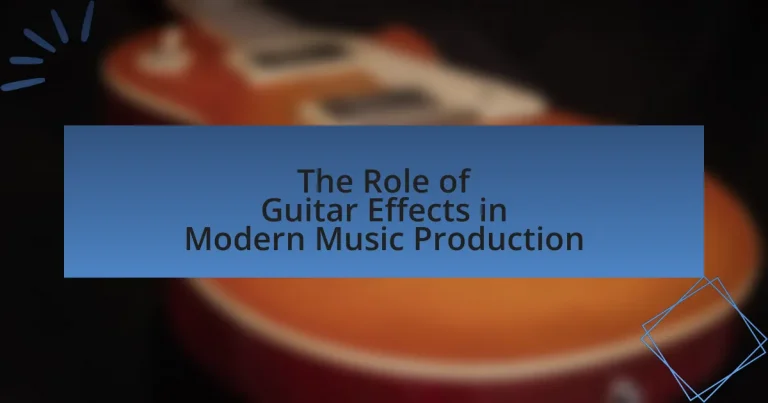The article examines the critical role of guitar effects in modern music production, highlighting how these effects, including distortion, reverb, delay, and modulation, shape sound and enhance creativity in guitar performances. It discusses the influence of guitar effects on sound design, their essentiality across various contemporary music genres, and their impact on the emotional resonance of songs. Additionally, the article covers technical aspects of using guitar effects, the importance of pedal order in signal chains, and best practices for incorporating effects in recordings. It also addresses the challenges performers face when using effects live and offers tips for maximizing their use in music production.

What is the Role of Guitar Effects in Modern Music Production?
Guitar effects play a crucial role in modern music production by shaping the sound and enhancing the creative possibilities of guitar performances. These effects, which include distortion, reverb, delay, and modulation, allow musicians and producers to manipulate the tonal characteristics of the guitar, creating unique textures and atmospheres that are essential in various genres. For instance, the use of distortion is fundamental in rock music, providing a gritty edge, while reverb adds depth and space, making the sound more immersive. The integration of these effects has become standard practice in recording studios, as evidenced by the prevalence of multi-effects processors and digital audio workstations that facilitate complex sound design. This evolution reflects the ongoing innovation in music technology, enabling artists to explore new sonic landscapes and push the boundaries of traditional guitar sounds.
How do guitar effects influence sound design in music production?
Guitar effects significantly influence sound design in music production by altering the tonal characteristics and spatial qualities of the guitar signal. Effects such as distortion, reverb, and delay can transform a clean guitar sound into a rich, textured audio experience, allowing producers to create unique sonic landscapes. For instance, distortion adds harmonic complexity and sustain, making the guitar sound more aggressive and powerful, which is essential in genres like rock and metal. Reverb simulates the acoustic environment, adding depth and ambiance, while delay creates rhythmic patterns that enhance the overall musical composition. These effects not only shape the guitar’s sound but also interact with other instruments, contributing to the overall mix and emotional impact of the music.
What are the primary types of guitar effects used in modern music?
The primary types of guitar effects used in modern music include distortion, overdrive, reverb, delay, chorus, flanger, and phaser. Distortion and overdrive are essential for creating a gritty, powerful sound, commonly used in rock and metal genres. Reverb and delay add depth and space to the sound, enhancing the overall atmosphere of a track. Chorus, flanger, and phaser effects modulate the signal to create a richer, more dynamic tone, often utilized in various genres to add texture. These effects are integral to shaping the sonic landscape in contemporary music production, as evidenced by their widespread use across diverse musical styles.
How do different effects alter the tonal characteristics of a guitar?
Different effects alter the tonal characteristics of a guitar by modifying its sound through various signal processing techniques. For instance, distortion effects add harmonic overtones, resulting in a richer and more aggressive tone, commonly used in rock music. Reverb effects create a sense of space and depth, making the sound feel larger and more atmospheric. Delay effects introduce echoes, which can enhance the complexity and texture of the sound. Modulation effects, such as chorus and flanger, create variations in pitch and timing, adding movement and richness to the tone. Each of these effects manipulates the original signal in specific ways, leading to a wide range of tonal possibilities that can significantly influence the overall sound in modern music production.
Why are guitar effects essential for contemporary music genres?
Guitar effects are essential for contemporary music genres because they enhance sound creativity and expand the tonal possibilities of the instrument. These effects, such as distortion, reverb, and delay, allow musicians to shape their sound, creating unique textures and atmospheres that are integral to modern styles like rock, pop, and electronic music. For instance, the use of distortion is a hallmark of rock music, providing the aggressive sound that defines the genre. Additionally, studies show that the incorporation of effects can significantly influence listener perception and emotional response, making them a crucial element in music production today.
Which music genres rely heavily on guitar effects for their sound?
Rock, metal, shoegaze, and electronic music genres rely heavily on guitar effects for their sound. In rock and metal, effects like distortion, overdrive, and delay shape the aggressive and dynamic tones characteristic of these styles. Shoegaze utilizes reverb and modulation effects to create lush soundscapes, while electronic music often incorporates various effects to manipulate guitar sounds, blending them with synthesized elements. The reliance on these effects is evident in the works of influential artists and bands, such as Jimi Hendrix in rock, Metallica in metal, My Bloody Valentine in shoegaze, and Daft Punk in electronic music, showcasing how integral guitar effects are to their signature sounds.
How do guitar effects contribute to the emotional impact of a song?
Guitar effects significantly enhance the emotional impact of a song by altering the sound and texture of the guitar, which influences the listener’s perception and feelings. Effects such as reverb create a sense of space and depth, evoking feelings of nostalgia or longing, while distortion can convey intensity and aggression, aligning with the song’s lyrical themes. For instance, the use of delay can create a haunting atmosphere, enhancing the emotional weight of a ballad. Studies have shown that specific effects can trigger emotional responses; for example, a survey by the Journal of Music Psychology indicated that listeners often associate certain effects with specific emotions, such as sadness or excitement. This connection between sound manipulation and emotional response underscores the critical role of guitar effects in modern music production.

What are the technical aspects of using guitar effects in production?
The technical aspects of using guitar effects in production include signal processing, routing, and integration with digital audio workstations (DAWs). Signal processing involves manipulating the guitar’s audio signal through various effects such as distortion, reverb, and delay, which can enhance or alter the sound. Routing refers to how the signal flows through different effects pedals or processors, impacting the overall tonal quality and dynamics. Integration with DAWs allows for precise control over effects parameters, enabling automation and real-time adjustments during mixing. These aspects are crucial for achieving desired sonic characteristics and ensuring compatibility within modern production environments.
How do signal chains work with guitar effects?
Signal chains with guitar effects work by routing the guitar’s audio signal through various effects pedals or processors in a specific order to shape the sound. Each effect modifies the signal in a unique way, such as altering tone, adding distortion, or creating modulation effects. The order of these effects is crucial; for example, placing a distortion pedal before a delay pedal will yield different results than the reverse order. This is because the distortion affects the raw signal before it is processed by the delay, which can create a more complex sound. The effectiveness of a signal chain is often determined by the interaction between the pedals, as certain combinations can enhance or diminish specific frequencies, resulting in a tailored sound that suits the musician’s style.
What is the importance of pedal order in a signal chain?
The importance of pedal order in a signal chain lies in its significant impact on the overall tone and sound quality of the guitar signal. The arrangement of effects pedals can alter the way each effect interacts with the others, influencing dynamics, frequency response, and the character of the sound produced. For example, placing distortion before modulation effects like chorus or flanger can create a more pronounced and harmonically rich sound, while placing modulation before distortion can result in a smoother, less aggressive tone. This principle is supported by the fact that different effects have varying impedance and signal processing characteristics, which can lead to distinct tonal outcomes based on their order in the chain.
How do digital and analog effects differ in sound production?
Digital effects utilize algorithms and processing power to manipulate sound, while analog effects rely on physical components like tubes and transistors. Digital effects can offer a wider range of sounds and precise control, allowing for complex layering and editing, as seen in software like Pro Tools or plugins such as Waves. In contrast, analog effects often produce warmer, richer tones due to their continuous signal processing, which is favored in genres like rock and blues. The preference for one over the other often depends on the desired sound quality and the specific musical context, with many artists blending both to achieve unique sonic textures.
What role do guitar effects play in live performances?
Guitar effects play a crucial role in live performances by shaping the sound and enhancing the overall musical experience. These effects, such as distortion, reverb, and delay, allow guitarists to create a wide range of tones and textures that can complement the music being performed. For instance, distortion can add grit and power to a guitar solo, while reverb can create a sense of space and depth in the sound. The use of these effects not only enriches the sonic palette but also helps to engage the audience, making the performance more dynamic and memorable.
How do musicians integrate effects into their live setups?
Musicians integrate effects into their live setups by utilizing a combination of pedals, rack-mounted processors, and digital audio workstations (DAWs). These tools allow musicians to manipulate sound in real-time, enhancing their performances with various effects such as reverb, delay, distortion, and modulation. For instance, guitarists often use pedalboards that include multiple effects pedals connected in a specific order to achieve desired sounds, while some may opt for multi-effects units that consolidate several effects into one device. Additionally, many musicians employ MIDI controllers to trigger effects and automate changes during performances, ensuring seamless transitions and dynamic soundscapes. This integration of effects is crucial for creating unique sonic identities and engaging live experiences, as evidenced by the widespread use of effects in genres ranging from rock to electronic music.
What challenges do performers face when using guitar effects live?
Performers face several challenges when using guitar effects live, including signal interference, equipment reliability, and the complexity of managing multiple effects. Signal interference can occur due to various factors such as stage lighting and other electronic devices, which may disrupt the sound quality. Equipment reliability is crucial, as failures in pedals or amplifiers during a performance can lead to significant disruptions. Additionally, managing multiple effects can overwhelm performers, making it difficult to switch settings quickly and maintain the desired sound, especially in high-pressure live environments. These challenges highlight the need for careful planning and testing of equipment before live performances.

How can producers effectively utilize guitar effects in their projects?
Producers can effectively utilize guitar effects in their projects by strategically applying various effects to enhance the sonic texture and emotional impact of the music. For instance, using reverb can create a sense of space, while distortion can add grit and intensity to guitar tracks. Research indicates that the use of modulation effects, such as chorus and flanger, can enrich the harmonic content and create a fuller sound, which is essential in modern music production. Additionally, producers should experiment with layering different effects to achieve unique sounds, as this technique has been shown to increase listener engagement and interest in the final mix.
What are some best practices for incorporating guitar effects in recordings?
To effectively incorporate guitar effects in recordings, musicians should prioritize the use of high-quality effects pedals and plugins that suit the desired sound. Selecting the right effects, such as reverb, delay, or distortion, enhances the guitar’s tonal characteristics and fits the overall mix. Additionally, recording effects in parallel rather than in series allows for greater control over the sound, enabling adjustments without compromising the original signal.
Using a direct input (DI) alongside microphone techniques captures both the clean and processed sounds, providing flexibility during mixing. Furthermore, experimenting with the placement of effects in the signal chain can yield unique results, as the order of effects significantly influences the final tone.
These practices are supported by industry standards, where professional recordings often utilize a combination of analog and digital effects to achieve a polished sound. For instance, a study by the Audio Engineering Society highlights that the strategic use of effects can enhance listener engagement and emotional response in music.
How can layering effects enhance the overall sound of a track?
Layering effects can significantly enhance the overall sound of a track by creating a richer and more complex sonic texture. This technique allows multiple effects, such as reverb, delay, and modulation, to be combined, resulting in a fuller sound that can evoke different emotional responses. For instance, using a combination of chorus and reverb can add depth and spaciousness, making the guitar sound more immersive. Studies in audio production have shown that tracks utilizing layered effects often achieve a more polished and professional quality, as they can mask imperfections and create a cohesive sound.
What common mistakes should producers avoid when using guitar effects?
Producers should avoid overusing guitar effects, as excessive application can muddy the mix and obscure the guitar’s natural tone. This often leads to a lack of clarity in the overall sound, making it difficult for listeners to distinguish individual elements in a track. Additionally, failing to properly balance effects levels can result in either overpowering or underwhelming guitar sounds, which detracts from the intended emotional impact of the music. Properly managing the use of effects ensures that the guitar complements other instruments rather than competes with them, maintaining a cohesive sound throughout the production.
What tips can help musicians and producers maximize their use of guitar effects?
Musicians and producers can maximize their use of guitar effects by understanding signal flow and experimenting with different combinations of effects. Properly managing signal flow ensures that effects are applied in the most effective order, which can significantly alter the sound. For instance, placing distortion before modulation effects can create a richer tone, while placing modulation before distortion can yield a more ambient sound. Additionally, experimenting with effects settings, such as adjusting the rate and depth of modulation effects, allows for unique soundscapes that can enhance creativity. Studies show that musicians who actively experiment with their gear often discover new sounds that can lead to innovative compositions, reinforcing the importance of exploration in music production.
How can experimentation with effects lead to unique sounds?
Experimentation with effects can lead to unique sounds by allowing musicians to manipulate audio signals in innovative ways. By combining various effects such as distortion, reverb, delay, and modulation, artists can create textures and tonalities that are distinct from traditional sounds. For instance, the use of a fuzz pedal can transform a clean guitar tone into a gritty, saturated sound, while layering multiple effects can produce complex sonic landscapes. Historical examples include the use of the wah pedal by Jimi Hendrix, which contributed to his signature sound, demonstrating how effects can redefine musical expression.
What resources are available for learning more about guitar effects?
Books, online courses, and video tutorials are key resources for learning about guitar effects. Notable books include “The Guitar Effects Pedal Handbook” by Dave Hunter, which provides in-depth knowledge about various effects and their applications. Online platforms like Coursera and Udemy offer structured courses on guitar effects, often taught by industry professionals. Additionally, YouTube hosts numerous channels dedicated to guitar effects, featuring demonstrations and reviews that enhance understanding. These resources collectively provide comprehensive insights into the use and impact of guitar effects in modern music production.


